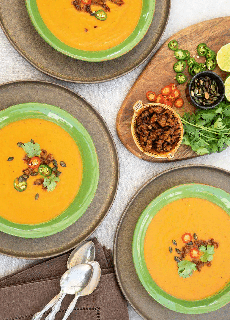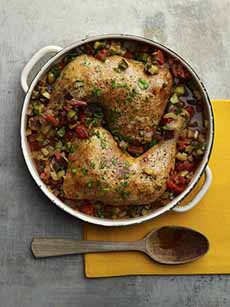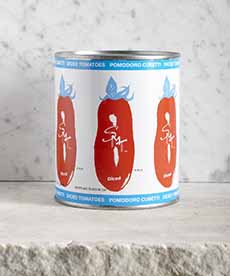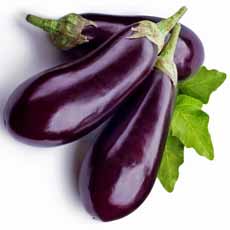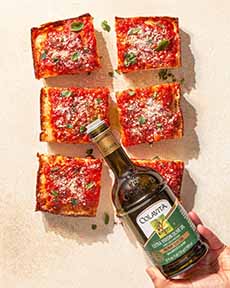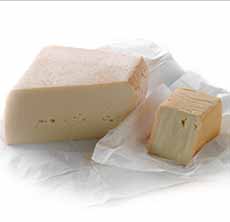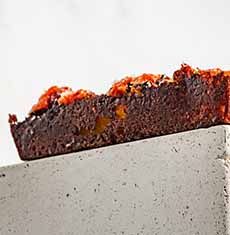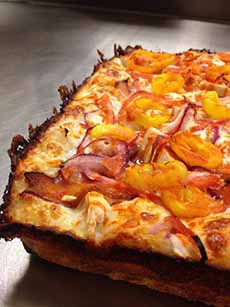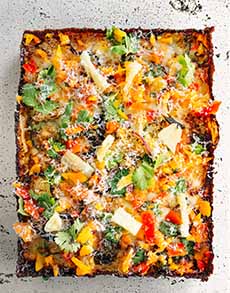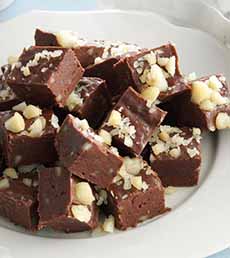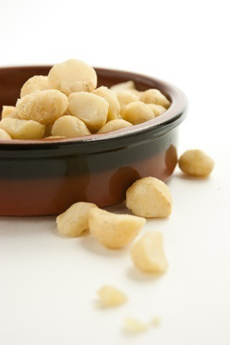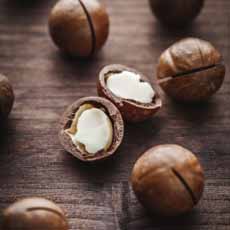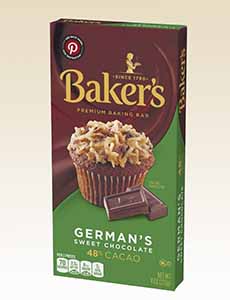|
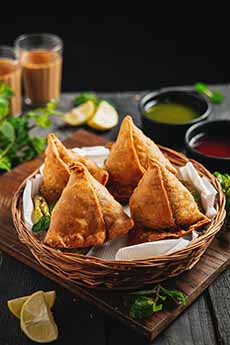
[1] Classic samosas are triangular in shape (photo© Satyam Verma | Pexels).

[2] The most popular filling combines potatoes, onions, and green peas with a variety of spices, including black mustard seeds, coriander, cumin, curry powder, garlic, ginger, and jalapeño. Here’s the recipe (photo © Oona Settembre | David & Busters | Dallas | Idaho Potato Commission).
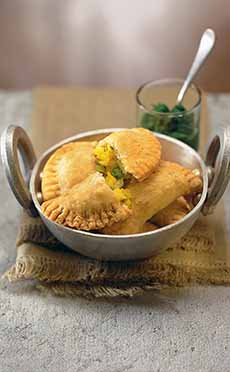
[3] Notice the half-moon shape on these cauliflower and cabbage samosas. Here’s the recipe (photo © Rich Vellante | Legal Seafoods | Idaho Potato Commission).

[4] Here’s the recipe at right for Meatless Beef Samosas. You can serve a couple of samosas with a small salad as a snack or first course (photos #4, #5, and #6 © Hannah Kaminsky | Bittersweet Blog).

[5] Prepping for the Meatless Beef Samosas.
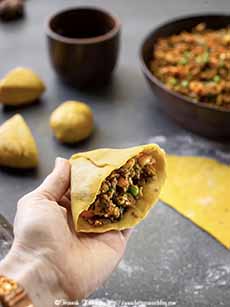
[6] The delicious Meatless Beef filling.
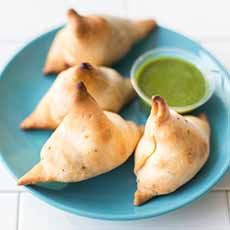
[7] Baked samosas with mint chutney (photo © Good Eggs).
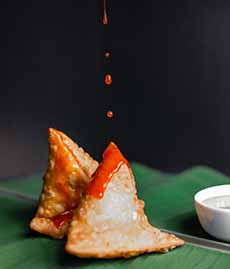
[8] A fusion approach: Samosas with hot sauce instead of chutney—although some chutneys are pretty hot (photo © Shreyak Singh | Unsplash).(
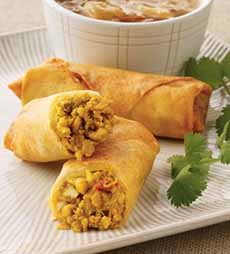
[9] Samosa filling in an egg roll wrapper (photo © Allen Brothers).

[10] Sweet potato samosas with raisin chutney (photo © The Fry Family Food Co. | Unsplash).
|
|
Ah, crispy samosas! September 5th is World Samosa Day. Is there a food holiday for everything? Sadly, some of our favorite foods have been overlooked in the holiday department. We have a running list that’s nearing 100, from A (arugula) to Y (yogurt—there’s no Z). Overlooked are everything from the basics (Greek salad, potato salad, sorbet) to the specialty (Dirty Martini, rugelach, steak tartare).
Thankfully our colleague Hannah Kaminsky, a wonderful vegan recipe developer, provided us with this delicious way to celebrate samosas.
Her recipe is meatless, but you can substitute meat. Although if you’ve never tried meatless alternatives, you’re missing out. And…no one will realize this hearty recipe is completely meatless!
For fried food fans, samosas are a welcome snack, appetizer, or entrée. They’re great with a beer or a glass of wine. Or that overlooked Dirty Martini.
If you don’t want fried food, there are instructions for air-frying and oven-baking.
If you’d like to create a well-rounded plated meal with samosa as the centerpiece, just add one or more sides:
Basmati rice
Chopped cucumbers and tomatoes
Leafy green salad
Lentil dal
Rasam (spicy tomato soup)
Samosas are meant for dipping. Popular choices:
Coconut chutney
Mint chutney (photo #7)
Raita (yogurt-cucumber dip, recipe)
Tamarind chutney
You can make these or purchase them. Greek tzatziki is an excellent substitute for raita.
The recipe follows.
Below:
> The history of samosas.
> The year’s 5 Indian food holidays in the U.S.
RECIPE: MEATLESS BEEF SAMOSAS (VEGAN)
Hannah calls this recipe “Love Triangles” (photo #4). Prep time is 45 minutes, and cook time is 15 minutes. You’ll need an additional 30 minutes of waiting time for the dough to rise.
Although samosas are traditionally deep-fried, you can pan-fry or shallow-fry them. Instructions for air-frying and baking are below.
Extra filling (photo #6) can be turned into a chip dip (you can mix it with yogurt), hamburger bun samosa, pizza topping, or vegan Bolognese sauce.
Ingredients For The Pastry Dough
2 cups all-purpose flour
1/2 teaspoon baking powder
1/2 teaspoon salt
1/4 teaspoon ground turmeric
1/4 teaspoon ground black pepper
1/4 cup coconut oil, melted
1/2 cup warm water
Ingredients For The Meatless Filling
3 tablespoons coconut oil
2 carrots, peeled and finely diced
1/2 large red onion, diced
1-2 Jalapeño or serrano chile peppers, seeded and minced
3 cloves garlic, minced
1/2 teaspoon whole cumin Seeds
1/2 teaspoon ground ginger
1/2 teaspoon Kashmiri chili powder or paprika
1/2 teaspoon ground turmeric
1/2 teaspoon salt
1 (8-Ounce) package tempeh, crumbled
1 cup soaked shiitake mushroom stems and/or caps, minced
2 tablespoons soy sauce
1 tablespoon lemon juice
1 tablespoon garam masala
1/4 teaspoon ground cinnamon
1/2 cup frozen green peas
1/4 cup fresh mint, minced
For frying: neutral vegetable oil
Preparation
1. MAKE the pastry dough. Combine the flour, baking powder, salt, turmeric, and pepper in a large bowl. Slowly pour in the oil and water while mixing with a sturdy wooden spoon. Once it becomes too stiff to stir easily, knead by hand until the dough is smooth. If the air is very dry, you may need to add another splash of water. Cover with a clean kitchen towel and let rest at room temperature for 30 minutes. Meanwhile…
If you don’t want to make pastry dough, there are quick-fix solutions you can purchase for the outer wrapping such as burrito-sized flour tortillas, phyllo dough, pie dough, puff pastry, and spring roll or egg roll wrappers (photo #9).
2. PREPARE the filling by placing the coconut oil in a medium saucepan over medium heat. Once melted, add the carrots, onion, peppers, and garlic, sautéing them into a softened aromatic, for 5-8 minutes. Add the cumin seeds, ginger, chili powder, turmeric, and salt, and cook for another minute.
3. TURN DOWN the heat and add the tempeh, using a spatula to break up any remaining large pieces. Incorporate the minced shiitakes, soy sauce, and lemon juice, stirring well. Sauté for another 10 minutes, until lightly browned around the edges.
4. ADD the garam masala and cinnamon, mixing well, then immediately remove from the heat. Stir in the peas, allowing them to thaw from the residual heat, followed by the mint. Transfer the filling to a separate bowl and let it cool to room temperature. When you’re ready to assemble the samosas…
5. LIGHTLY DUST a clean surface with flour. Take the rested dough and cut it into 6 equal pieces. Working with one piece at a time, roll it into a ball and then use a rolling pin to flatten it into an even circle, about 7-8 inches in diameter. Use a sharp knife to cut it into half; you now have two half moons.
6. TAKE one half and roll it into a cone, lightly moistening the edge with water and pressing the edges to seal. Stuff with 3-4 tablespoons of the filling, pressing down gently. Moisten the bottom edges and fold them over, pressing them together to create a neat little pyramid. Repeat with the remaining dough and filling. Cover the finished samosas with a clean kitchen towel to prevent them from drying out.
7. COOK. Heat at least 1 inch of oil to shallow fry, or 2-3 inches of oil to deep fry, using a heavy, high-sided pan set over medium heat. Add 2-3 samosas at a time, being careful not to crowd the pan. Fry for 3-5 minutes on each side, flipping as needed, until golden brown all over. Remove with a slotted spoon and drain on paper towels.
To air-fry: Lightly spray the samosas with a thin coating of oil and air fry at 370°F for 15 minutes, flipping after 10 minutes, until crispy and browned on both sides.
To bake: Preheat a conventional oven to 400°F. Bake for 20-30 minutes, flipping halfway through, until golden brown.
Serve hot!
THE HISTORY OF SAMOSAS
Samosas, the quintessential street food of India, did not originate there but thousands of miles away on the Iranian plateau*. The origins of its name are Persian: sanbosag.
We don’t know when the first cooks shaped pastry into triangles, filled them with meats and vegetables, and fried them. We do know that The first known mention of the sanbosag is by the Persian historian Abul-Fazl Beyhaqi, writing in the 11th century (although typically, dishes have been in existence known much longer than their first-known notation).
Beyhaqi describes a fine pastry, a dainty delicacy served as a snack in the great courts of the Ghaznavid dynasty which ruled large parts of Persia, Khorasan, much of Transoxiana† and the northwest Indian subcontinent from 977 to 1186.
There, the triangular pastry was filled with minced meats, nuts, and dried fruits and then fried until crisp.
The Sambosag Migrates East
The dainty sambosag was transformed into the robust samosa by waves of migration from the Middle East to India. Traders and other travelers brought the recipe through Central Asia, and then over the mountains in what is now Afghanistan. Some descended down the mountains onto the plains of India (more about that in a minute).
By the time the recipe reached what is now Tajikistan and Uzbekistan it was no longer a fine pastry, but a crude peasant dish—much larger and heartier, the type of food a shepherd would take out into the pastures for his midday meal.
The samosa retained its triangular shape and was still fried, but the nuts and fruits were gone, replaced with the simple fillings available: coarsely chopped goat or lamb with chopped onions and some salt.
The Samosa Arrives In India
Over the following centuries, the samosa made its way over the icy passes of the Hindu Kush mountain range and into the Indian subcontinent.
Once in India, the samosa was tailored to local tastes, incorporating Indian spices: caraway seeds, coriander, ginger, pepper, and numerous others.
The filling changed, too, with vegetables often replacing meat.
Even the shapes evolved beyond the triangle. There are now cone and half-moon-shaped samosas (photo #3), depending on the region. We’ve even seen egg roll-shaped samosas (photo #9).
These days most samosas are filled with ingredients that came all the way from the New World: chiles, peas, and potatoes, for example. New World ingredients came to India by way of Portuguese traders in the 16th century.
Onions, another key ingredient, are believed to have originated more than 5,000 years ago in Central Asia. They’re one of the most ancient of cultivated food sources.
|
The Recipes Proliferate
Not surprisingly, each region and town put its own favorite ingredients in its samosas.
Today, as then, samosas can even vary from shop to shop as samosa-makers compete for customers.
Samosas are now a worldwide treat. The British carried the recipe across their vast empire. The Indian diaspora—Indians who are living abroad and those who can trace their ancestry to India—did the same.
Thus, the fried tidbit of ancient Persian rulers is now enjoyed in virtually every country on Earth [source].
They can be jumbo-sized to serve as an entire meal, or bite-sized for cocktail canapés.
In Punjab samosas include paneer, the fresh Indian cheese, among their ingredients. Cheese is not used elsewhere.
Most samosas are still fried, but baked samosas have appeared for the calorie-conscious.
There even are dessert samosas, filled with chocolate, cheesecake, fruits, and Nutella.
A mixture of potatoes, onions, peas or lentils, and spices remain the most popular filling. It is typically served with different varieties of chutney.
You can check out the different types of samosas—from the Middle East, the Indian subcontinant, and Africa—here.
THE YEAR’S 5 INDIAN FOOD HOLIDAYS IN THE U.S.
January 12: National Curried Chicken Day
January 14: National Undhiyu Day
September 5: World Samosa Day
September 21: National Chai Day
October, 1st Full Week: National Curry Week
Plus:
January 16: International Hot & Spicy Food Day
> The Numerous Food Focused Holidays In India
________________
*The Iranian Plateau extends from East Azerbaijan Province in the northwest of Iran (ancient Persia) all the way to Afghanistan and Pakistan west of the Indus River. It also includes smaller parts of the Republic of Azerbaijan, Iraqi Kurdistan, and Turkmenistan.
Transoxiana or Transoxania (“Land beyond the Oxus”) is the Latin name for a region and civilization located in lower Central Asia. It roughly corresponds to modern-day eastern Uzbekistan, western Tajikistan, parts of southern Kazakhstan, parts of Turkmenistan, and southern Kyrgyzstan. Geographically, it is the region between the Amu Darya River to its south and the Syr Darya River to its north. Here’s more about it.
†National Undhiyu Day, held every January 14th, celebrates the a mixed vegetable curry that’s a regional specialty of the Gujarati people of India. Here’s a recipe.
CHECK OUT WHAT’S HAPPENING ON OUR HOME PAGE, THENIBBLE.COM.
|
